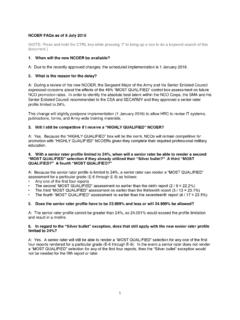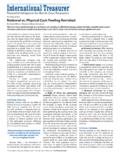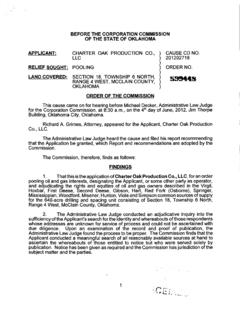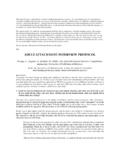Transcription of FREQUENTLY ASKED QUESTIONS 1. What are the …
1 1 FREQUENTLY ASKED QUESTIONS Demarcation between Health Insurance Policies and Medical Schemes 1. What are the basic principles of a health insurance policy how does it work? A health insurance policy1 is a binding contract issued by an insurance company to an individual. The policy can be sold by an insurance company in terms of the Long-term or Short-term Insurance Acts and is subject to regulatory oversight by the Financial Services Board ( FSB ). The policy promises to pay for certain stated benefits when the individual is ill or injured. The individual pays a certain premium which is directly related to the age, health status or income of the individual. Specific type of exclusions may also be built into a policy, which can have the effect of limiting who the policy can be sold to.
2 2. What are the basic principles of medical schemes how does it work? Medical schemes are regulated in terms of the Medical Schemes Act and are subject to regulatory oversight by the Council of Medical Schemes ( CMS ). They are non-profit organisations and belong to their members. Medical schemes operate through the collective pooling of good and bad risks, and may not discriminate between individuals based on age or health status. Contributions apply universally to all members who are enrolled and may only vary in respect of the cover provided. Different benefits options are priced differently depending on the level of cover afforded and are determined by the rules of the scheme. The effect is that there are equal premium contributions for high and low risk members, which promotes greater equity in the scheme.
3 3. What is the current market challenge? One of the concerns which the Demarcation Regulations ( Regulations ) seek to address relate to contentions that certain health insurance products (which provide similar benefits to medical schemes) in the long-term and short-term insurance market cause harm to the medical schemes environment by attracting younger and generally 1 Referred to as health policies under the Long-term Insurance Act and accident and health policies under the Short-term Insurance Act. 2 healthy members out of medical schemes. This practise if left unchecked could result in increasing costs for the older and less healthy who remain dependent on medical schemes for their cover. Pooling healthier and sicker individuals facilitates a form of cross-subsidisation whereby sicker people do not pay contributions according to their health status; this improves the affordability of medical schemes.
4 4. How do the Regulations address the current market challenge? The Regulations provide for types of policies that will be allowed to be sold in the long-term and short-term insurance market. In determining whether a product should be allowed to be sold, consideration was given to the current or potential harm that a health insurance policy may cause to medical schemes environment. 5. What is the danger of not having an appropriate demarcation framework in place? The public are often unaware about the subtle differences between a health insurance and medical scheme product. For example, the belief is that that an insurance policy offers the same protection as a medical scheme, when in fact the protection is partial and conditional. This may result in individuals being under covered when serious health events arise.
5 The cost of medical scheme cover may increase for older/sicker individuals, as a result of younger/healthier individuals either leaving medical schemes while they are good risks. Anti-selective behaviour maybe encouraged by incentivising good risks to remain on insurance products until they need better health cover, at which point they seek to join a medical scheme. 6. Which products will be allowed to be sold in terms of the Regulations and why? A matrix of products which will be allowed to be sold as health policies for (long-term insurance) and accident and health policies (for short-term insurance) is attached to this FAQ. To protect the risk pooling achieved through medical schemes, the Regulations provide that a health insurance policy must not be directly linked to the cost of the medical care and must not cause harm to the medical schemes environment.
6 Products which provide for policy benefits relating to actual medical expenses associated with a health event and unambiguously constitute the business of a medical scheme are deemed harmful to the medical scheme environment and therefore will not be exempted in terms of the Demarcation Regulations. These products cause harm to the medical schemes environment as they encourage younger/healthier members within medical schemes to select reduced cover options in their medical schemes. The net effect is that costs begin to rise for older/sicker individuals as the cross subsidisation principle is undermined. Some of the products are 3 also designed to exclude cover for older members as they are deemed bad risk . Older/sicker people pay more for cover in comparison to younger people.
7 7. Why are HIV/AIDs and Frail Care cover explicitly allowed in the Regulations? HIV/AIDs and Frail Care cover have explicitly been allowed to be sold to the public, despite these products being directly related to the cost of medical care. Given the current social pressures in the public and private health care sectors, these products have been identified as exceptions in the Regulations as there is a direct public policy imperative to allow for such products to be provided in the market. This is a clear example of the role that voluntary health insurance products can play in addressing some of the pressures which exist in health sector. 8. Which health insurance products will be allowed? To the extent that a health insurance policy provides for loss of income and contingency expenses associated with a health event but are not directly related to medical expenses, it will be allowed with strict marketing conditions.
8 For example a policy that pays a lump sum benefit per day to take care of contingency expenses in the event of a health condition. 9. What restrictions will be imposed on marketing? Restrictions will be imposed on the marketing of health insurance policies to ensure that the public clearly understands that the policy is not a substitute for a medical scheme. Policies may not include the term medical and hospital or any derivative thereof in their marketing material. All new health insurance policies are further required to be approved by the FSB prior to their launch to ensure that their benefits and marketing material are in line with the requirements of the Regulations. 10. What consultation process was followed to draft the Regulations? To address the regulatory and legal uncertainty in the market, in 2009, the National Treasury established a work group which included representatives from the Department of Health, FSB, CMS, Association of Savings and Investments South Africa and the South African Insurance Association.
9 The Regulations represent the outcome of a robust consultative process with all affected stakeholders. 11. What is being done to address the affordability of medical schemes especially given the rising cost of private health care? The issue of rising cost of private health care is subject to a separate process which is currently being addressed by the Department of Health and the CMS. 4 12. How do the Regulations fit in the context of National Health Insurance? The Regulations are seen as critical interim measures to preserve the viability of medical schemes which are seen to be an important vehicle for alleviating some of the current pressures which exist in the public health care system. National Health Insurance is a long-term health policy goal been lead by the Department of Health.
10 The Regulations also support the risk pools envisaged in the NHI in the same way that medical scheme risk pools should be protected against the harmful effects of some health insurance products which undermine the purposes of the Medical Schemes Act. 13. What are the transition arrangements? The effect of the regulations is that policies that fall outside the scope of the Regulations will not be allowed to be renewed. Exempted policies which were entered into by an insurer after 15 December 2008 must be brought in line with the draft Regulations. Insurers are therefore required to submit information on policies as prescribed in the Regulations to the FSB and the CMS. 14. What are the implications of the Regulations on existing policyholders? Existing policyholders who have health insurance policies which fall outside the Regulations are encouraged to review their health coverage.

















